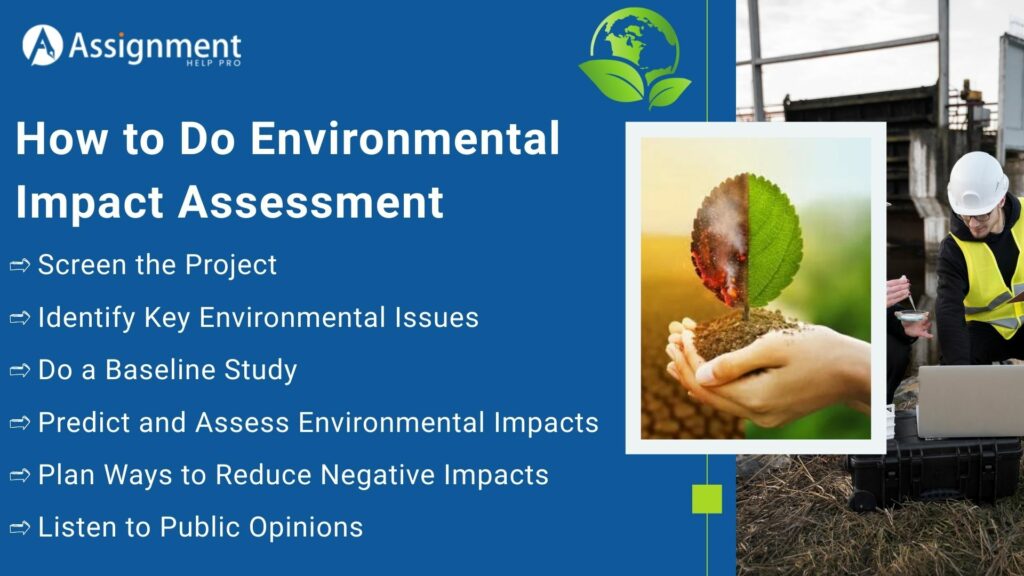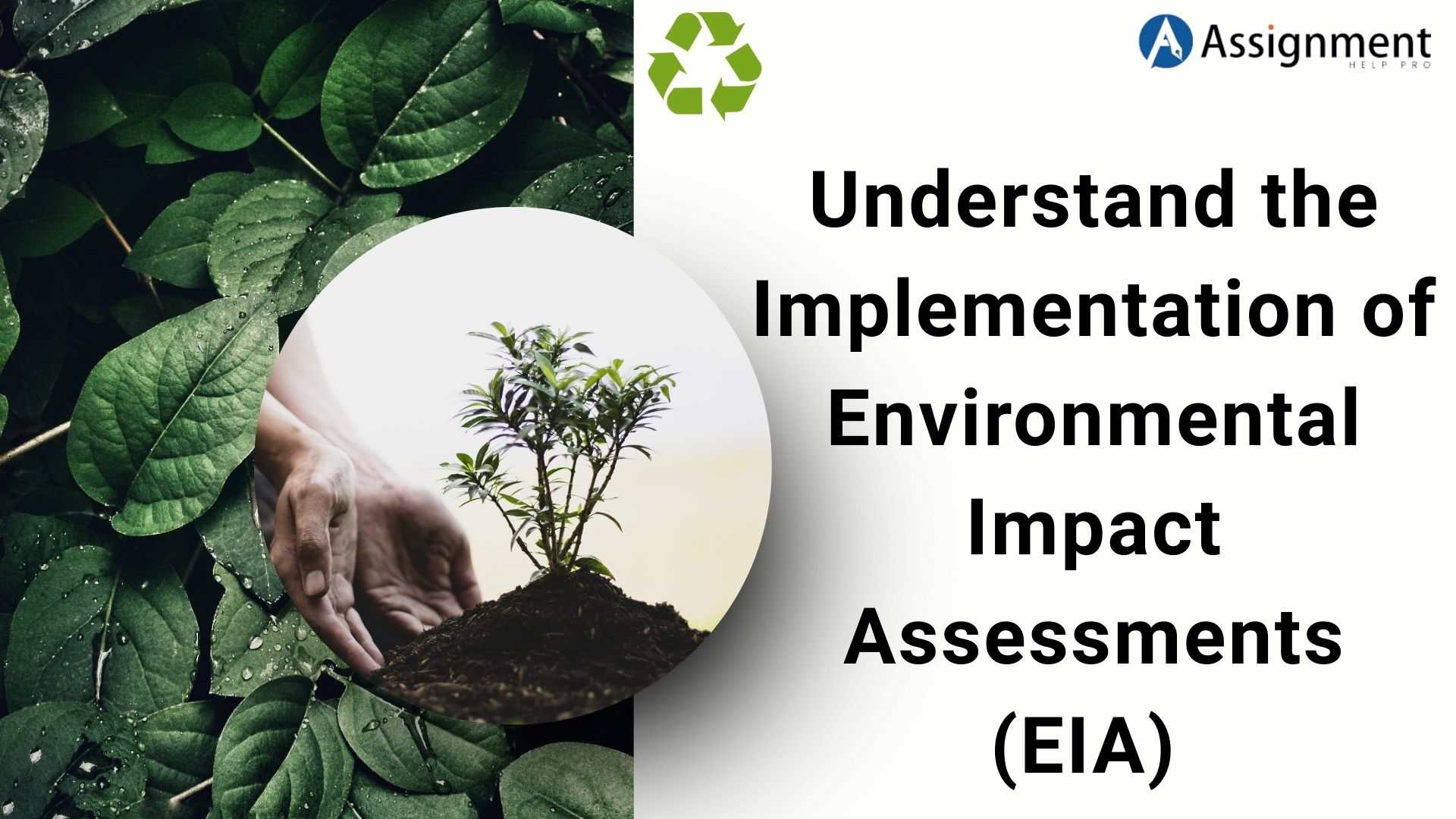If you want to make your project sustainable, then focus on the implementation of Environmental Impact Assessment (EIA). To perform EIA, identify the potential environmental issues, study the current situation, predict impacts, and find ways to minimize harm. Finally, engage with the community and make informed decisions for a sustainable future.
Environmental Impact Assessment (EIA) is an important tool that supports sustainable development. You can use it to study how a project may affect the environment before making any decisions. This, in turn, will help you ensure that development and environmental protection go hand in hand. If you are an environmental science student, then you might have to prepare assignments on EIA. Generally, to write such assignments, you must have a strong knowledge of EIA and the ways to implement it. If you are unsure how to perform an environmental impact assessment, then read this blog or send a ‘take my online environmental class for me’ request to experts to understand all about EIA. Here, we have explained what an EIA means, along with its key components and the challenges involved in EIA implementation.
What is an Environmental Impact Assessment?
Environmental Impact Assessments (EIAs) are the best tools that support sustainable development. They generally help decision-makers look at how a proposed project might affect the environment, not just its economic or social benefits. Specifically, by studying these impacts early, EIAs can also help plan projects in a way that protects nature. Most importantly, with this approach, you can meet today’s needs while still protecting the planet for future generations. Overall, EIAs play a vital role in finding and reducing harmful effects, promoting care for the environment, and leading to smarter, more responsible decisions.
International Standards and Legal Frameworks for EIA
Many countries have rules that say important projects must have Environmental Impact Assessments (EIAs). These rules make sure the possible effects on the environment are carefully studied before the project starts. International groups like the World Bank and the United Nations also require EIAs for projects they fund. Such requirements show how important the environment is for development worldwide.
For example, the European Union has the EIA Directive, and the United States has the National Environmental Policy Act (NEPA). Both laws make EIAs mandatory for big projects. This shows their commitment to protecting the environment and promoting sustainable development.
Why is EIA Important for Sustainable Development?
Environmental Impact Assessments matter for sustainable development because of the following reasons:
- It helps to protect plants, animals, and natural habitats by stopping damage to important ecological areas.
- EIAs check for pollution and work to keep the air, water, and soil clean and safe.
- EIAs give local communities a chance to share their concerns. This, in turn, helps them ensure their health and resources are protected during development.
How to Do Environmental Impact Assessment
Typically, before you start a project, you must understand how it might affect the environment. An Environmental Impact Assessment will help you do that by guiding you through a step-by-step process. If you are unsure how to carry out an EIA effectively, then follow these steps
Screen the Project
It is the first step in the EIA implementation. Initially, you should figure out whether your project needs a full Environmental Impact Assessment (EIA) or not. You should make this decision by looking at how your project might affect the environment. If it seems like the impact could be serious, you can go ahead with a detailed EIA.
Identify Key Environmental Issues
Scoping is the second step, where you will have to decide what environmental issues your assessment should focus on. During this stage, you should look at key areas like how your project might affect animals, water sources, and air quality. The goal of scoping is to find the most important concerns so you can study them closely. This, in turn, will help you make sure your Environmental Impact Assessment is complete and focused.
Do a Baseline Study
Next, conduct a baseline study. It is all about gathering detailed information on the environment before your project begins. In this step, you should collect data on things like air, water, soil, plants, and animals in the location. This will give you a clear picture of the current conditions. Later, you can use this information to see how the environment changes during and after the project.
Predict and Assess Environmental Impacts
In this step, you should predict how your project might affect the environment. Specifically, you should look at things like how serious the impacts could be, how long they might last, and how likely they are to happen. This involves using both numbers and observations to study different parts of the environment. The ultimate goal of this step is to understand how big the overall impact could be.
Plan Ways to Reduce Negative Impacts
Once you predict and assess environmental impacts, come up with ways to reduce or avoid the negative effects of your project. This might include changing parts of the project, using better technology, or following proven methods. These actions will help you protect the environment. Overall, this step aims to lower the harm and increase any positive outcomes from the project.
Listen to Public Opinions
Finally, consult the public, which includes local communities, stakeholders, and environmental groups, about the project. During public consultation, people will share their thoughts and concerns about the project. Generally, listening to their opinions will help you make better and more balanced decisions.
When implementing EIA, you may face certain issues. So, you should be prepared to handle them effectively. If it is troublesome for you to perform environmental impact assessments or prepare academic papers or case studies on such topics, you can approach the subject experts for assignment help. They will assist you in completing your work in the best possible way.
Challenges Involved in Environmental Impact Assessment Implementation
Generally, the implementation of EIA will be more challenging. Often, various factors like limited data, lack of public involvement, and weak enforcement can affect their effectiveness. However, by understanding these challenges, you can improve the EIA process.
- Sometimes, important project decisions are made before the EIA is finished. This means the assessment doesn’t fully influence those decisions.
- At times, confusion about which projects actually need an Environmental Impact Assessment arises.
- People often don’t fully understand how to describe the current environment and predict future impacts correctly.
- The assessment may become more complex when it is tough to connect environmental effects with social, economic, and health issues.
- EIA reports can be too long and complex. Hence, both decision-makers and the public may find it hard to understand.
- There are no clear systems to make sure EIA reports are used in decision-making.
- The recommendations in EIA reports for reducing harm and monitoring impacts are often not followed during the project.
- Many countries lack the technical skills and management needed to carry out proper Environmental Impact Assessments.
Final Words
Environmental Impact Assessments are a significant way to balance building projects with protecting the environment. Governments, businesses, and communities need to work together to make sure EIAs help create choices that are good for both people and nature. This teamwork can lead to a cleaner and healthier future. If you struggle to do your environmental science assignments on EIA, reach out to us immediately. We will offer you the best environmental science assignment help services to meet your requirements. Moreover, you can also widen your knowledge of EIA by sending our professionals a ‘Take My Online Class for Me.’ This will help you do the work by yourself and achieve the top scores.





